Disclosure: This post may contain affiliate links. I may earn a small commission for my endorsement, recommendation, testimonial, and/or link to any products or services from this website.
A simple, hearty, and nourishing pork stew is perfect cool-weather comfort food! The one pot meal is loaded with bacon, smoked sausage, tender meat, vegetables, beans, and herbs in a thick, rich gravy. Pair each bowl with cornbread muffins, buttermilk biscuits, or soft and fluffy crescent rolls for a satisfying, cozy supper.
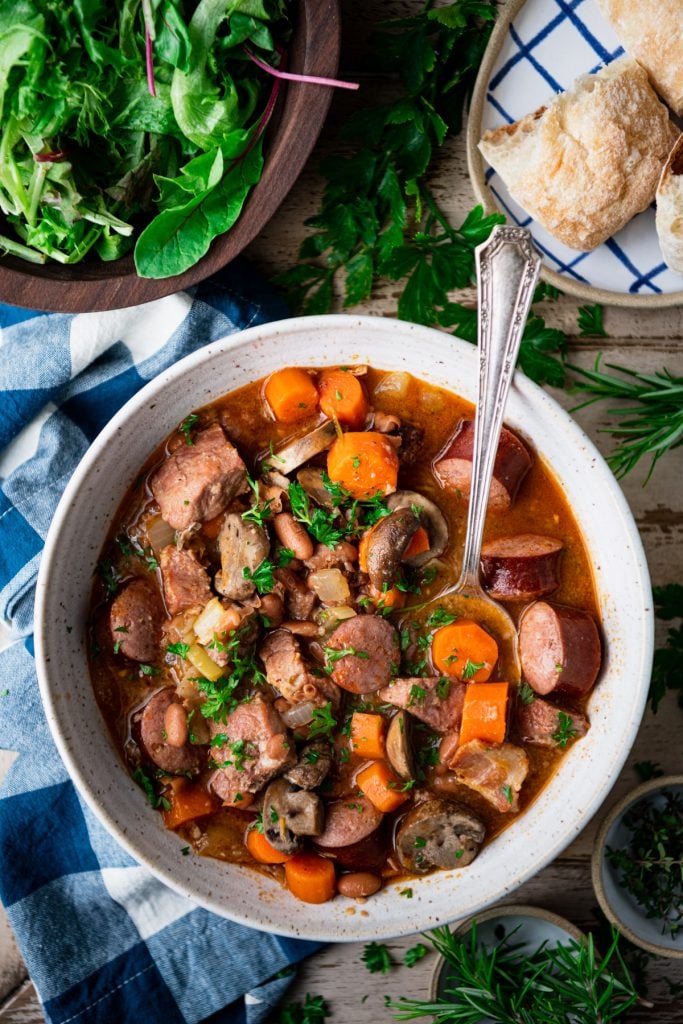
Table of Contents
For even more Dutch oven pork recipes, try these Dutch oven pork chops, this Mississippi pulled pork, and this Dutch oven pork roast with gravy, too!
On a chilly day, nothing beats a warm pot of Dutch oven pork stew. It’s total comfort food! The aroma that wafts through your home as it cooks all afternoon is like a warm hug from your grandmother! The melt-in-your-mouth easy dinner recipe gives you succulent pork and flavorful vegetables that have soaked up all of the juices from the meat. It’s truly the perfect supper to serve on a quiet Sunday evening.
Simple Pork Stew
A classic pork stew is a simple combination of chunks of pork, smoked sausage, bacon, vegetables, and beans (or potatoes) that are braised in liquid and served in their thick, rich gravy. There are endless combinations of meat and veggies, some of which are slow-cooked in the oven, others that are made in a Crock Pot, and old-fashioned recipes like this that simmer on the stovetop in a big cast iron Dutch oven.
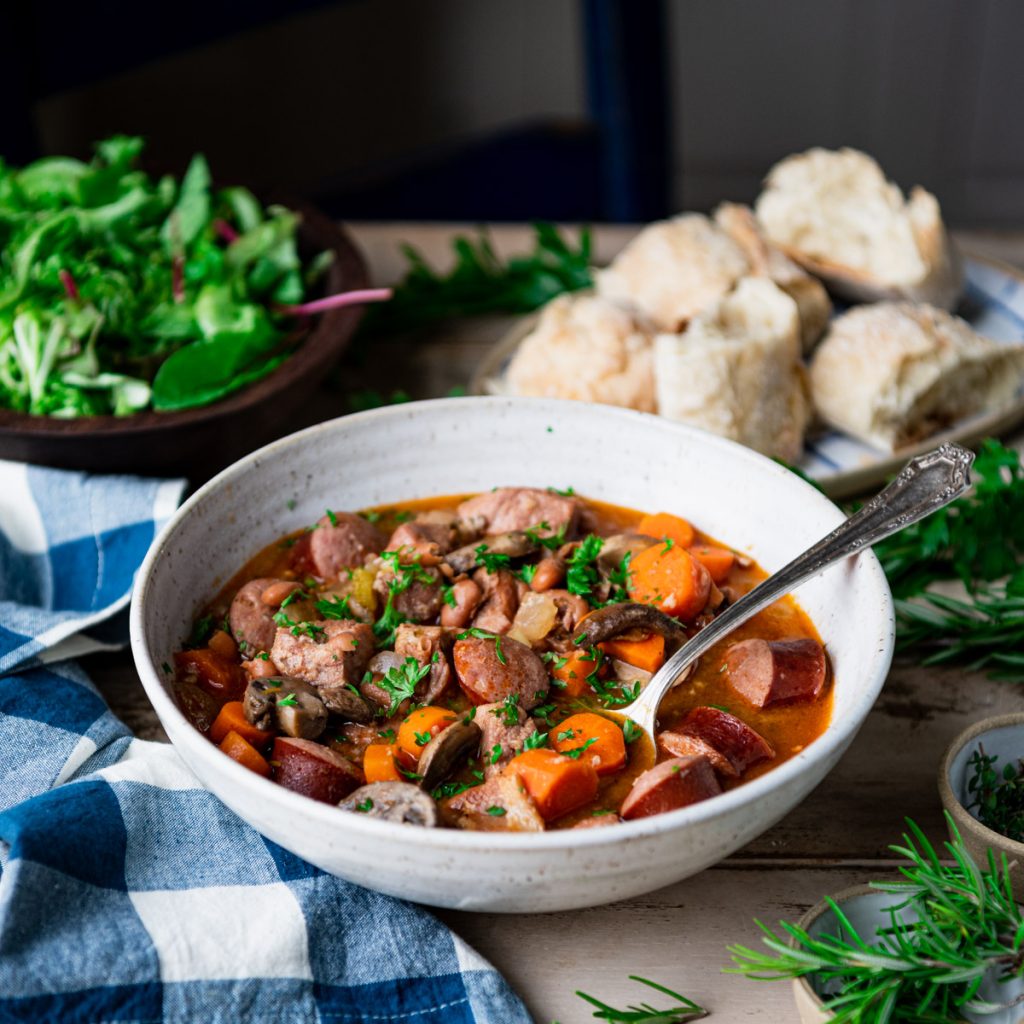
Why Use a Dutch Oven for Pork Stew
Many folks prefer the convenience of a Crock Pot slow cooker or even an Instant Pot, but I find that the Dutch oven yields the best tasting pork stew every time. Dutch ovens are made from cast iron, so they retain and evenly distribute the heat. Plus, the tight-fitting lid traps the moisture inside the pot — resulting in the juiciest stew and meat that you will ever taste.
Instead of dried-out pork and mushy vegetables that have been cooked to death in a slow cooker, you can easily control the cooking time of all of the individual ingredients when using a Dutch oven. Plus, you get those great browned bits at the bottom of the pot after browning the meat, which add tons of flavor to the stew.
The Best Dutch Oven to Use for Pork Stew
We rounded up the best Dutch ovens you can buy, including 3 (yes, 3!) that I personally own and love! It was difficult to choose my favorite, but the Staub Cast Iron Dutch Oven (5.5 quarts) earned the top spot. You can buy it on Amazon for $311.50 or at Walmart for $359.95. That said, the Le Creuset Enameled Cast Iron Dutch oven was a close second that’s just a little bit larger (7.5 quarts). It’s available on Amazon for $459.95.
The Secret to Good Stew
The secret to good stew lies in the layering of flavors and high-quality ingredients. You build these layers of flavor in the Dutch oven as you saute the bacon, sear the pork and sausage, deglaze the pot, and simmer the dish low and slow. Cooking the stew long enough is also an important tip, since this process breaks down the tough connective tissue and fiber in the meat, yielding a flavorful, tender, and juicy pork stew.
What to Add to Pork Stew to Make it Taste Better
We’ve tried plenty of mediocre stew recipes over the years, but there are a few ingredients in this dish that set it apart from the rest.
- First, the bacon. This provides a rich, smoky flavor in the background, and creates drippings that help to flavor and brown the pork.
- Next, the apple cider or wine. Again, it adds depth of flavor to the broth and pairs beautifully with the meat.
- Finally, the vinegar. All of the best recipes include a bit of acid to really brighten up the dish, and this stew is no exception!
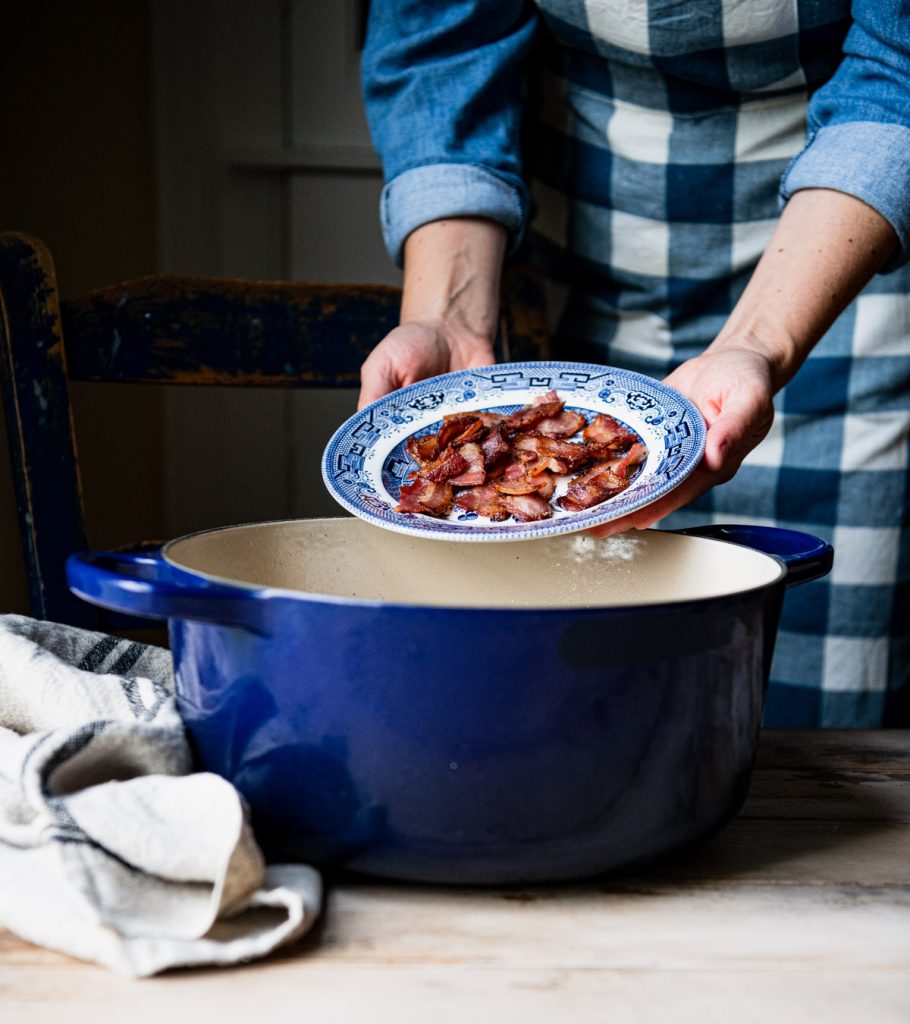
What cut of meat is pork stew meat?
Stewing pork, or pork stew meat, is pork cut into serving-size chunks or cubes, intended for cooking with stewing or braising methods. The meat is usually sold boneless, and is typically cut from areas of the pig that have a lot of tough connective tissue, collagen, and fat, which makes it ideal to stand up to the long, slow cooking process.
This recipe calls for diced boneless pork shoulder (also called a “pork butt” or a “Boston butt”). This is the same cut that’s typically used for pulled pork, and comes from high on the hog, above the shoulder blade. It has a lot of juicy, marbled fat, which lends itself well to juicy, slow-cooked meat. You can purchase a whole boneless pork shoulder or pork butt to use in this recipe, use pre-diced pork stewing meat, or pick up pork shoulder “steaks” sold in smaller quantities that you can dice at home.
How to Make Pork Stew Tender
Patience! The key to tender pork in your stew is just cooking it long enough. You can’t rush a pot of pork stew, which does best when given the opportunity to simmer low-and-slow on your stovetop. This low, slow cooking process gradually breaks down the tough connective tissues and fibers in the meat, yielding a perfectly tender pot of stew!
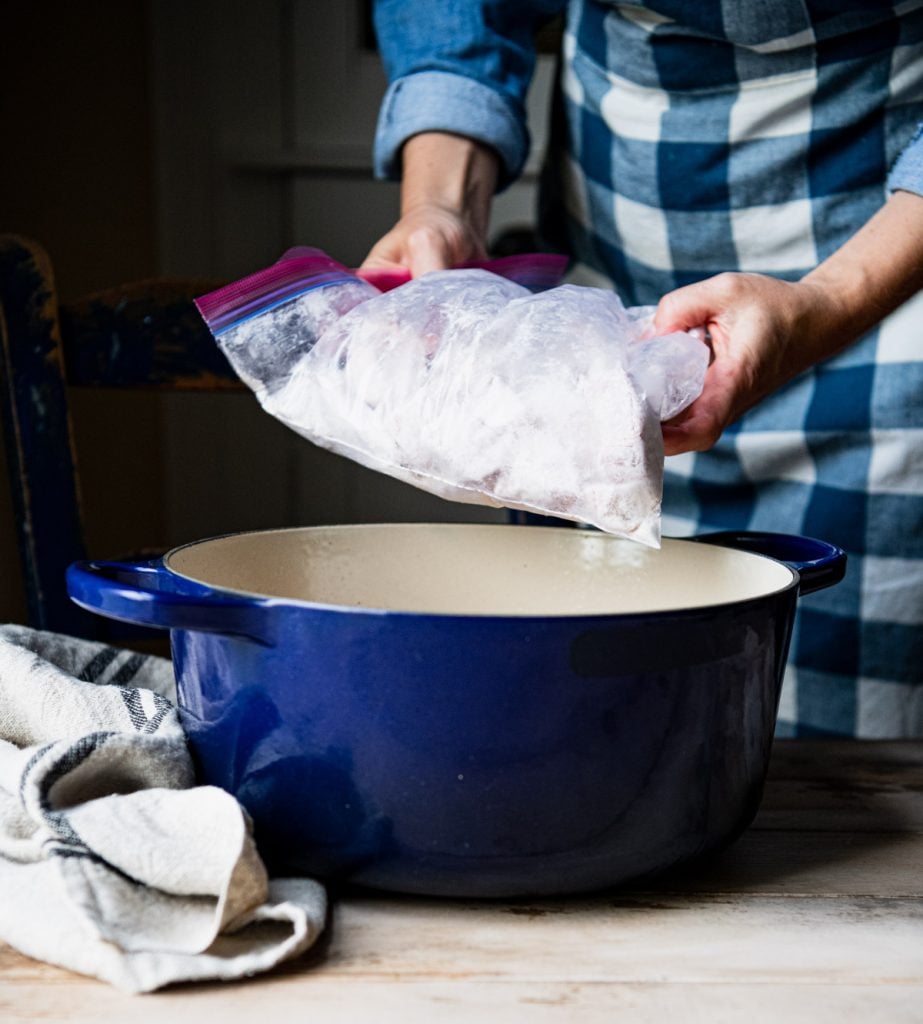
Ingredients
This is just a quick overview of the ingredients that you’ll need for a simple pork stew recipe. As always, specific measurements and step-by-step cooking instructions are included in the printable recipe box at the bottom of the post.
- Butter: to brown and flavor the bacon and pork.
- Bacon: gives the stew a smoky flavor and creates drippings for browning the meat.
- All-purpose flour: to coat the pork, which helps it develop a brown crust on the outside and thickens the stew slightly. Discard any excess flour.
- Pork shoulder: or substitute with other diced pork stewing meat. You can use a pork loin roast or even pork chops, but the meat won’t be quite as juicy and fall-apart tender.
- Smoked sausage: gives the stew even more rich, smoky flavor.
- Apple cider or white wine: adds bold depth of flavor to the stew and helps to deglaze the pot.
- Apple cider vinegar: a touch of acidity brightens up the dish.
- Tomato paste: adds flavor and thickens the stew.
- Kosher salt and ground black pepper: enhance the other flavors.
- Garlic, rosemary, thyme, bay leaf, paprika: add savory flavor. You’ll need about 3 garlic cloves to equal 1 tablespoon minced.
- Chicken broth or chicken stock: the liquid base of the stew. Use a low-sodium or unsalted variety to control the sodium in the stew. Substitute with beef broth if you like.
- Onion, carrots, celery, and mushrooms: additional veggies that add flavor and texture to the meal.
- Beans: an Appalachian-inspired addition, pinto beans or other canned beans add flavor and texture to the stew, and also pair nicely with the sausage and pork. See my notes below if you prefer to substitute with potatoes instead of beans.
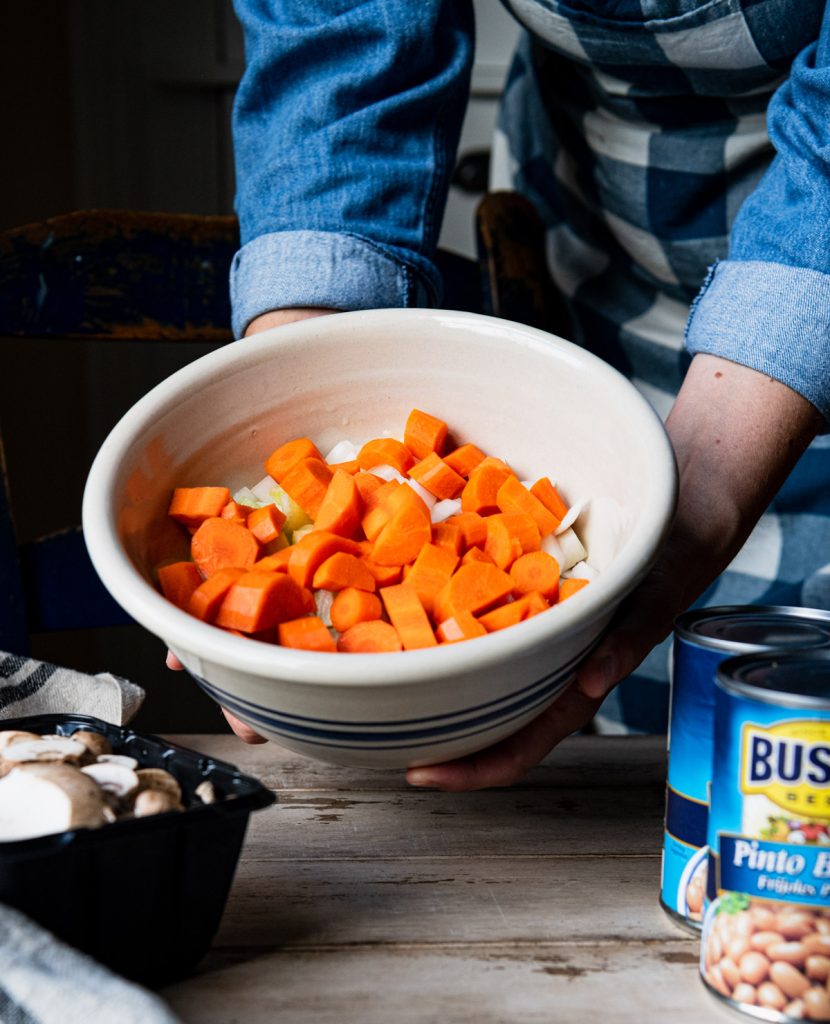
How to Cook Pork Stew
This pork shoulder stew develops so much flavor as you layer ingredients and slowly simmer the pot on the stove. It’s not difficult, but it does require more than 2 hours from start to finish — making it ideal for a quiet Sunday supper.
- Sauté bacon in butter in a large Dutch oven.
- Toss the chunks of pork shoulder with seasoned flour to coat.
- Sear pork and sausage in the butter and bacon fat until browned on all sides.
- Deglaze the pot with apple cider or white wine and vinegar.
- Add the bacon, pork, and sausage back to the pot, along with the tomato paste, garlic, salt, pepper, rosemary, thyme, bay leaf, paprika, and broth.
- Boil, then reduce the heat to low.
- Cover and cook, stirring occasionally, until the pork is fork-tender — about 1-1½ hours.
- Add the onion, carrots, and celery; simmer (covered) for 10 minutes.
- Stir in the beans (or potatoes) and mushrooms. Simmer, covered, until the vegetables are tender, about 30-40 more minutes.
- Discard the bay leaf, season with salt and pepper (if necessary), then ladle into bowls. Garnish with chopped fresh herbs, such as parsley, and serve!
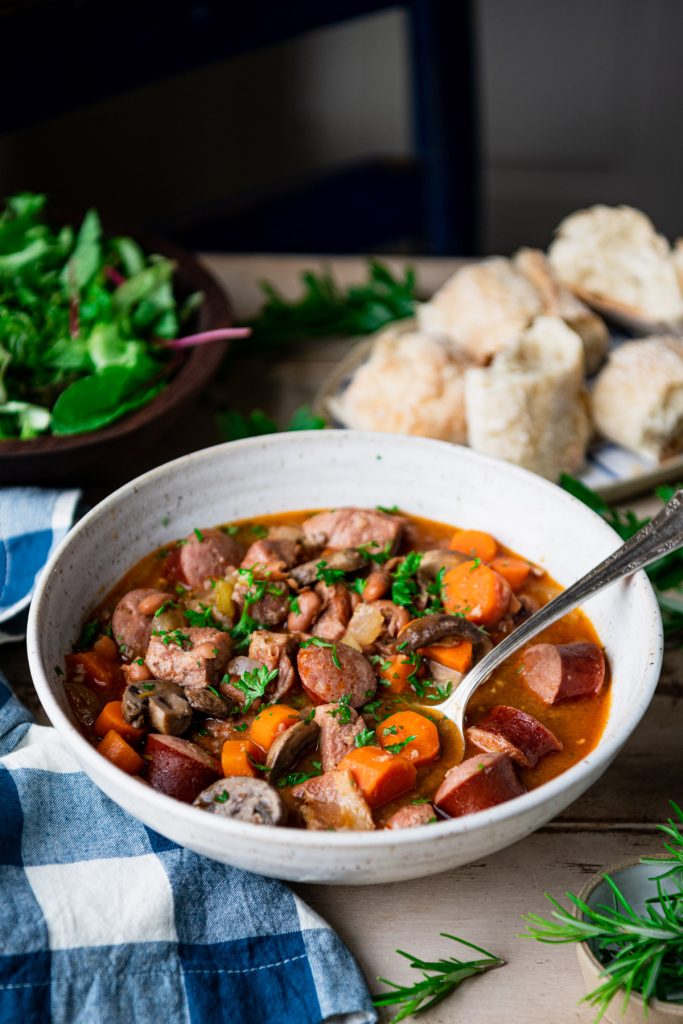
Serving Suggestions
Since it’s full of meat, veggies, and beans, this is a great one-pot meal! That said, here are a few easy options to serve with your Dutch oven pork stew:
- 3-Ingredient Buttermilk Biscuits, Sweet Potato Biscuits, Flaky Biscuits, Cheese Biscuits or Drop Biscuits
- Southern Cornbread, Cake Mix Cornbread, Pumpkin Cornbread, Skillet Cornbread, Sweet Cornbread, Jiffy Cornbread with Creamed Corn, Corn Sticks, Mexican Cornbread, Honey Cornbread or Cornbread Muffins
- Pumpkin Bread, Pumpkin Muffins, Cranberry Muffins, or Apple Muffins
- Crusty French Baguette, Soft Dinner Rolls, or Homemade Crescent Rolls
- No-Knead Bread
- 3-Ingredient Beer Bread
- Southern Collard Greens
- 3-Ingredient Sour Cream Muffins
- Green Salad with Red Wine Vinaigrette, Mixed Greens with Dijon Vinaigrette, Caesar Salad, Fall Salad with Maple Balsamic Dressing, House Salad with Candied Pecans
- Fried Corn
- Southern Fried Apples, Baked Apple Slices, or Applesauce
- Egg noodles
- Hush Puppies
- Coleslaw or Vinegar Coleslaw
- Hoe Cakes
- Baked Potato Wedges, Mashed Sweet Potatoes, Rosemary Roasted Potatoes, Skin-On Mashed Red Potatoes, Mashed Potatoes with Sour Cream and Chives, or 3-Ingredient Buttermilk Mashed Potatoes
- Roasted Broccoli
- Fried Cabbage with Apples and Onion or Braised Red Cabbage
- Sauteed Kale with Bacon or Sauteed Spinach with Garlic
- Amish Green Beans with Brown Butter or Southern-Style Green Beans
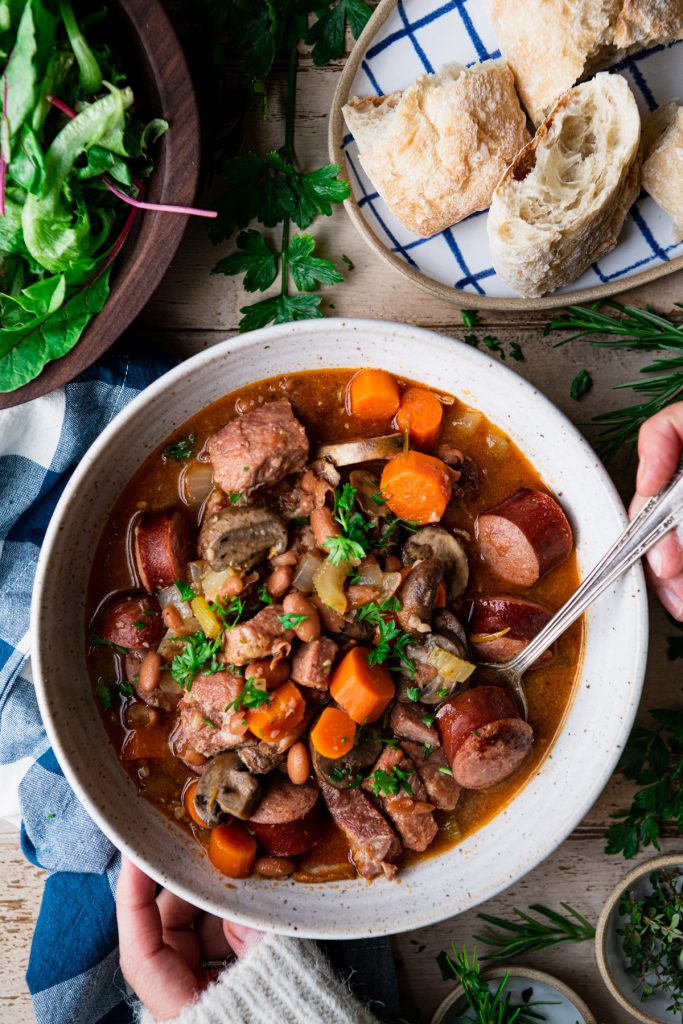
Storage
Stored properly in an airtight container, the leftover stew will keep in the fridge for 3-4 days. You can also keep the leftovers in airtight containers in the freezer for up to 3 months. Thaw frozen stew in the refrigerator overnight before reheating.
How to Reheat
When chilled, the fat from the stew will rise to the top and harden. You can use a spoon to scrape off most of the fat, or you can simply leave it in the pot and stir it back into the dish when it heats up. Place the cooked stew in a saucepan or Dutch oven on the stovetop. Cover and warm over low heat, just until the stew reaches the desired temperature. If it seems dry, you can add more broth to thin, as necessary.
You can also reheat individual portions in the microwave for 1-2 minutes on high, or until warmed through.
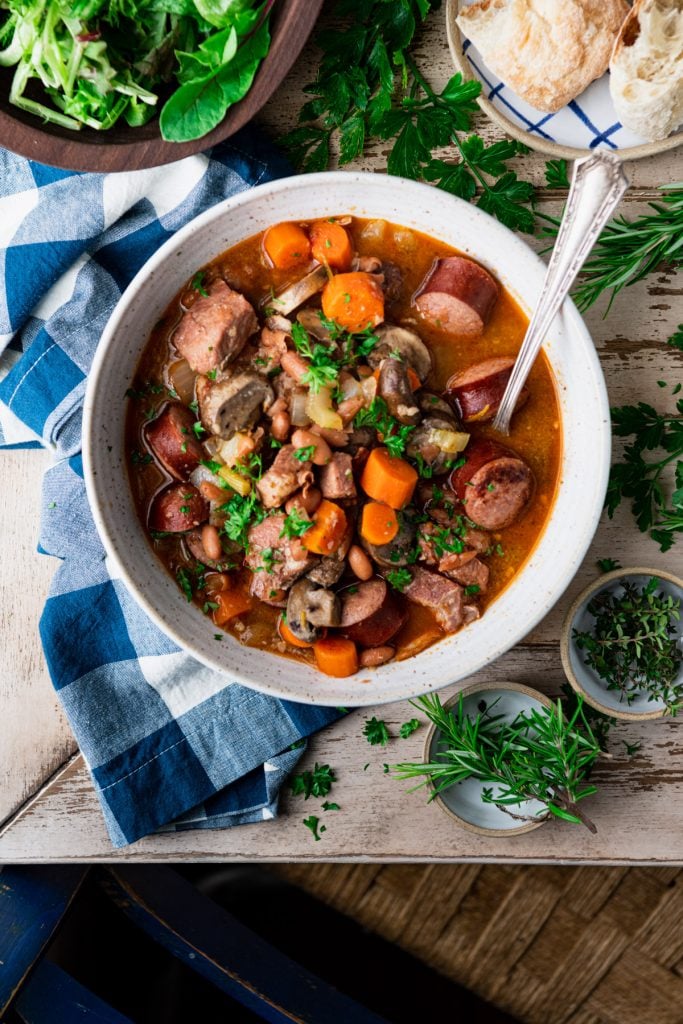
Recipe Variations
- You can use pork tenderloin in this stew, but it will have a very different texture than the tender, juicy pork shoulder. Since tenderloin is a lean cut, it does best with shorter, higher temperature cooking methods (such as searing and grilling). If you choose to use tenderloin here, I recommend cooking the meat in the bacon drippings all of the way through (rather than just browning). Then reduce the simmering time so that it’s warmed through, but it doesn’t become overdone, tough, and dry.
- Instead of the canned beans, add 3 russet potatoes, peeled and chopped into ¾-inch cubes, at the same time that you add the mushrooms. If using red potatoes or gold potatoes instead of russets, you do not need to peel them.
- If you don’t care for mushrooms, you can substitute with frozen peas or corn.
- The apple cider gives the dish so much flavor; however, you can also use wine to deglaze the pan if that’s what you prefer.
- Apple cider vinegar pairs nicely with the cider and pork, but balsamic vinegar or red wine vinegar are also good alternatives.
- In lieu of butter, brown the bacon and pork in olive oil or vegetable oil.
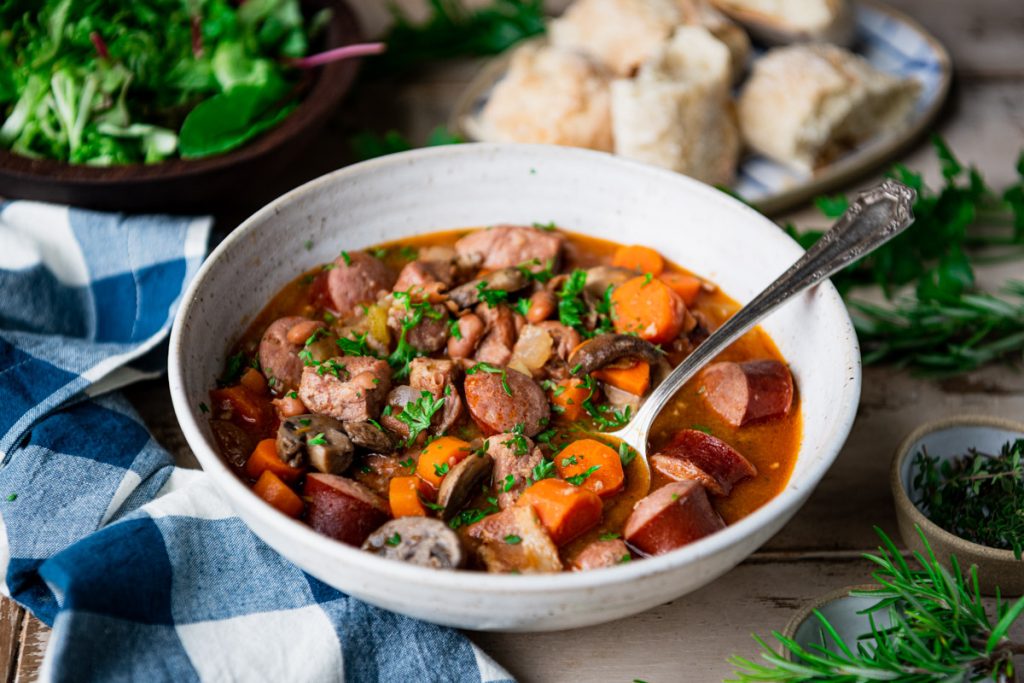
Tips for the Best Pork Stew Recipe
- Dredge the meat in the seasoned flour. This helps the pork caramelize and brown in the pan, while the flour also thickens the gravy in the stew.
- Brown the meat. This is an extra step, but it’s worth the effort. The caramelized surface gives the pork and sausage extra flavor, while the browned bits and drippings in the pot add even more flavor to the stew.
- To make the pork stew tender, it’s important to cook the pork long enough to break down the tough connective tissue and fibers. If your meat is still tough after about 1 hour, simmer the stew a little bit longer before adding the vegetables.
- While the tomato paste isn’t a mandatory ingredient, it adds rich tomato flavor to the stew. I highly recommend including this extra layer of complexity to the dish!
- Keep the Dutch oven covered while simmering in order to trap moisture in the stew. You should end up with the perfect ratio of thick, rich gravy by the end. If you find that the stew is too thick, just add an extra splash of broth until it reaches the desired consistency.
- Choose a low-sodium or unsalted chicken broth or chicken stock if you like to control the sodium in your stew. Don’t forget that the bacon and smoked sausage also contribute salty flavor to the dish.
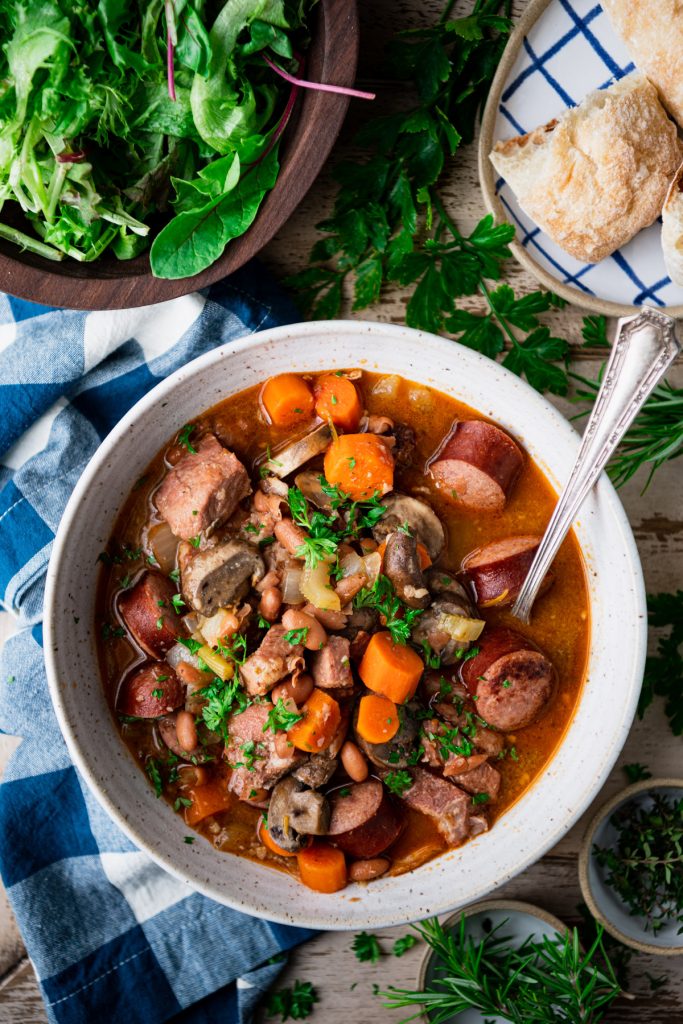
More Pork Shoulder Recipes to Try
- Pulled Pork Casserole with Cornbread Topping
- Crock Pot Pulled Pork with Apricot Preserves
- Slow Cooker Carnitas {Mexican Pulled Pork}
- Pulled Pork Nachos
- Cider Braised Pork Shoulder Roast
- Crock Pot Pulled Pork
- Dr. Pepper Pulled Pork
- Slow Cooker Pulled Pork with Alabama White BBQ Sauce
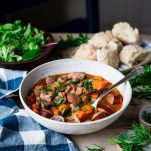
Dutch Oven Pork Stew
Ingredients
- 1 tablespoon butter
- 4 slices bacon, chopped
- ½ cup all-purpose flour
- 2 lbs. boneless pork shoulder, trimmed and cut into 1-inch pieces
- 1 lb. smoked sausage, cut into 1-inch pieces
- 1 cup apple cider or white wine
- 1 tablespoon apple cider vinegar
- 1 tablespoon tomato paste
- 1 tablespoon minced or pressed fresh garlic cloves
- 2 tablespoons chopped fresh rosemary (or 2 teaspoons dried rosemary)
- Leaves from 2 sprigs fresh thyme (or 1 teaspoon dried thyme)
- 1 bay leaf
- ½ teaspoon paprika
- 2 ½ cups low-sodium chicken broth or chicken stock, plus more as needed
- 1 large yellow onion, chopped (about 2 cups)
- 3 large carrots, peeled and chopped into bite-size pieces
- 1 stalk celery, chopped
- 2 (16 ounce) cans beans, drained and rinsed (such as pinto beans or cannellini beans)
- 8 ounces sliced fresh mushrooms
- Kosher salt and ground black pepper, to taste
- Optional garnish: chopped fresh parsley, rosemary, or thyme
Instructions
- In a large oven-safe pot or Dutch oven, sauté bacon in butter over medium heat until crisp and browned (about 3-5 minutes). Remove bacon with a slotted spoon and set aside.
- Pat pork shoulder dry with a paper towel.
- Place the flour in a bowl or large Ziploc bag and season with about ½ teaspoon of kosher salt and ½ teaspoon of pepper. Add the pork shoulder and toss to coat well. Remove coated pork from the bowl and discard any extra flour.
- Sear pork shoulder in the butter/bacon fat until browned on all sides (about 5 minutes). Depending on the size of your pot, you may need to work in batches so that the pork can brown without overcrowding.
- Remove the pork from the pot with a slotted spoon.
- Add the sausage to the pot. Cook, stirring occasionally, until the sausage is lightly browned, about 5 minutes. Remove the sausage from the pot with a slotted spoon.
- Add the wine (or apple cider) and vinegar. Cook over medium-high heat, scraping the pan with a wooden spoon to loosen any browned bits.
- Add the bacon, pork, and sausage back to the pot, along with the tomato paste, garlic, 1 teaspoon of kosher salt, ½ teaspoon of pepper, rosemary, thyme, bay leaf, paprika, and broth. Stir well to completely combine. Bring to a boil; then reduce to a low simmer.
- Cover and cook, stirring occasionally, until the pork is tender, about 1 – 1 ½ hours. You can tell the pork is ready when it’s tender and pulls apart easily with a fork.
- Add the onion, carrots, and celery and simmer, covered, for 10 minutes.
- Add the beans and mushrooms and simmer, covered, until the vegetables are tender, about 30-40 more minutes. Add more broth at the end to thin the stew, if necessary. Discard bay leaf; season with additional salt and pepper, to taste. Ladle into bowls and serve.
Notes
- Instead of the canned beans, add 3 russet potatoes, peeled and chopped into ¾-inch cubes, at the same time that you add the mushrooms. If using red potatoes or gold potatoes instead of russets, you do not need to peel them.
- If you don’t care for mushrooms, you can substitute with frozen peas or corn.
- The apple cider gives the dish so much flavor; however, you can also use wine to deglaze the pan if that’s what you prefer.
- Apple cider vinegar pairs nicely with the cider and pork, but balsamic vinegar or red wine vinegar are also good alternatives.
- In lieu of butter, brown the bacon and pork in olive oil or vegetable oil.


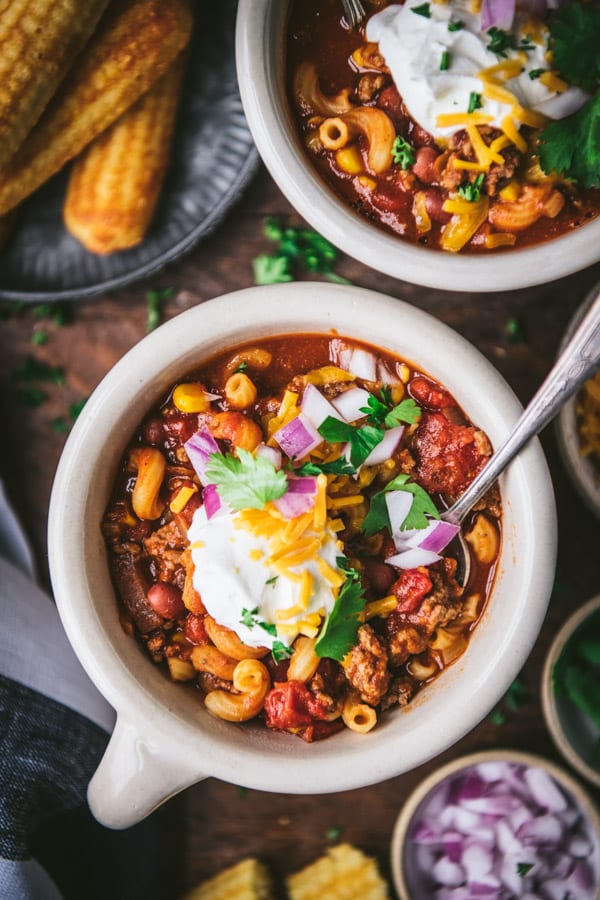
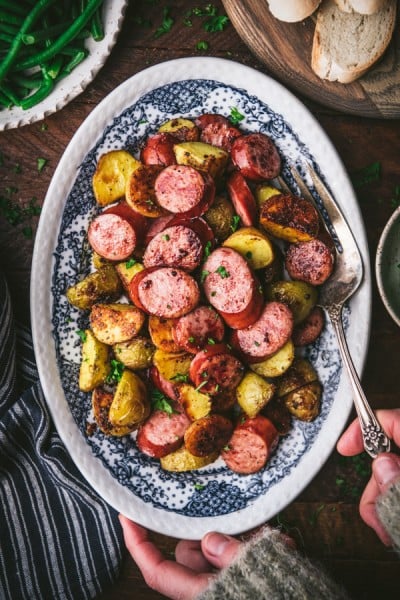








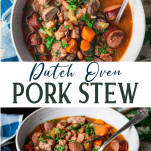
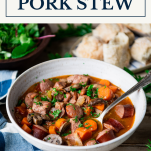
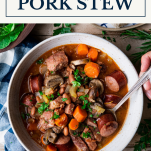
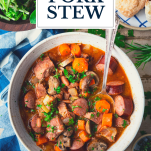
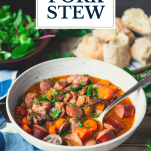
Ooh, Blair! You have outdone yourself this time, ma’am! I am sitting here with my mouth hanging wide open! I do believe you have convinced me to buy a cast iron dutch oven. But tell me again, please how big should it be to be useful and yet not be too big for me to wash in my sink and also do you recommend a particular brand. You certainly get a lot of use out of yours.
I will be freezing most of this so I suppose I would be better off using beans rather than potatoes.Also a big problem for me when I’m buying bacon and celery both is how to use up the rest after making my dish. Does your serch engine recognize ingredients. For instance, if I type in celery would it show me all recipes using celery or just the titles of recipes?
Again, so many of your recipes look fabulous and I’m sure they’re as good as they look.
Thank you, Marion. You’re very kind! Yes, the Dutch ovens and cast iron skillets are definitely my most-used kitchen tools. Don’t need too much else!
The Dutch oven that I use most often, and that I think is the most practical size for things like soups, stews, chilis, and roasts is the 7 1/4 -quart Le Creuset. It’s definitely an investment piece, but it’s also something that I use year-round, almost every day, and that should last for decades. Here’s the link to the one that I have: https://www.williams-sonoma.com/products/le-creuset-signature-round-dutch-oven/?catalogId=61&sku=3651037&cm_ven=PLA&cm_cat=Google&cm_pla=Cookware%20%3E%20Dutch%20Ovens%20%26%20Braisers®ion_id=477340&cm_ite=3651037_14571728103&gclid=CjwKCAjw4c-ZBhAEEiwAZ105Rese4i7O8IWX1nDgfNB4Om8w_zhm7gYP7e8U0YAOjs4D4RU62RhvnhoCrQEQAvD_BwE
For Dutch oven bread, I like a smaller pot in the 4-6 quart range. But again, the larger one is definitely more practical. Here’s the slightly smaller Dutch oven that I use often: https://smithey.com/products/5-5-qt-dutch-oven?gclid=CjwKCAjw4c-ZBhAEEiwAZ105RRadCOD_PJwFQ0w9tUzxUDo8Da872u-vpJ6tGk183RoWFiRo5voINRoC_aUQAvD_BwE
As for the search engine on my site, yes — it should pull up recipes that include specific ingredients (to an extent). It might miss some, but when you type “celery” into the search bar, you’ll find many recipes with celery in them. Hope that helps!
As I was about to say, I bet this is a favorite with your husband and sons. You have a great way with photography as well as words. There, now I’m done. Ha!
Thank you!!!
I’m not sure where to start, but DAAANG! This was beyond delicious. I went the potato route rather than beans. I used baby yellow, red and purple potatoes. I used a pre-packaged pork stew meat, only because my local grocery didn’t have a boneless pork shoulder. I encourage the use of fresh ingredients, stay away from canned things. Served it with lightly grilled sourdough bread. The pork and sausage, melt in your mouth tender. The broth, soooo rich and packed with underlying flavors. I wanted to go back for seconds and thirds, but was so full after two ladle falls, I simply could not. I’ll warm it up for lunch tomorrow. Thank you for this recipe Blair. ❤️
That’s the beauty of leftovers, Brett! So glad that you can continue to enjoy the meal. Thanks for your kind note!
Just bought Le Creuset oval Dutch oven and this was the first recipe I made in it. This recipe is amazing! There is so much depth of flavor. Hubs and three kids loved it too. I used 1/2 cup apple cider, 6 1/2 cups of broth, and potatoes instead of beans. I will definitely make this again.
We’re honored this was the first recipe you chose and are so glad you enjoyed it, Amber!
This turned out fantastic! I went by the recipe and my son loved it. His favorite part is the mushrooms and the tender meat. So many layers of flavors. Excellent recipe. Thanks for sharing.
My husband LOVED it, which means it was a hit. So yummy. That apple cider vinegar was surprisingly a yummy touch.
We’re so glad it was a hit! Thank you for trying it out, Carolina.